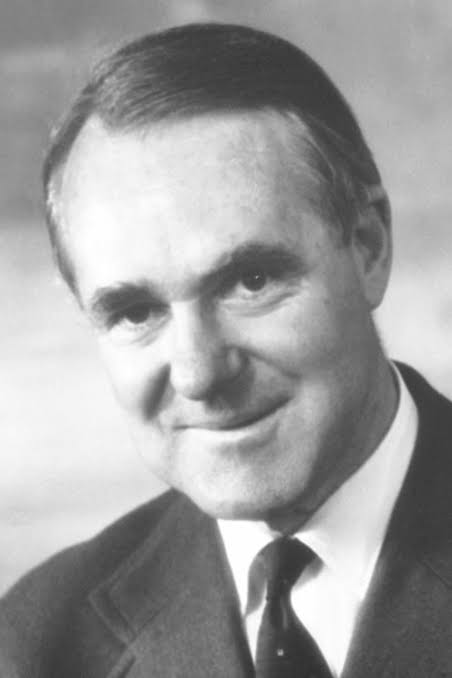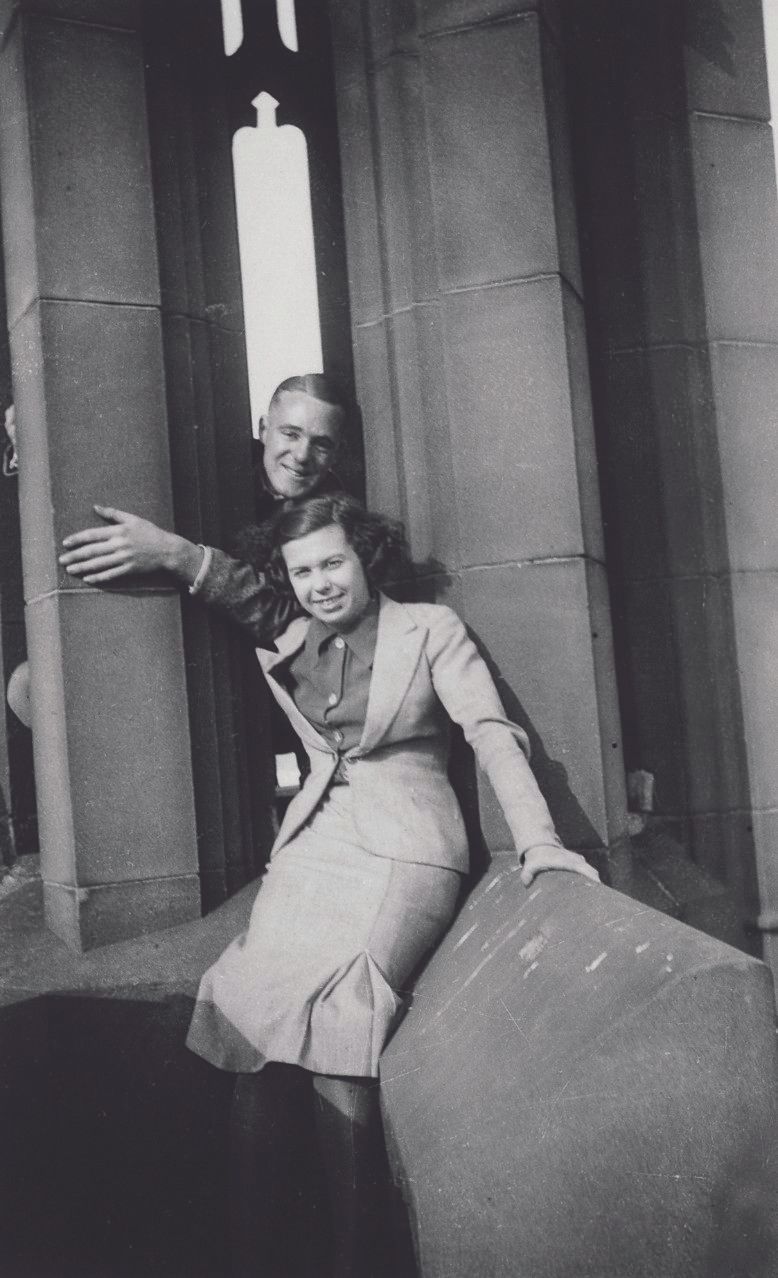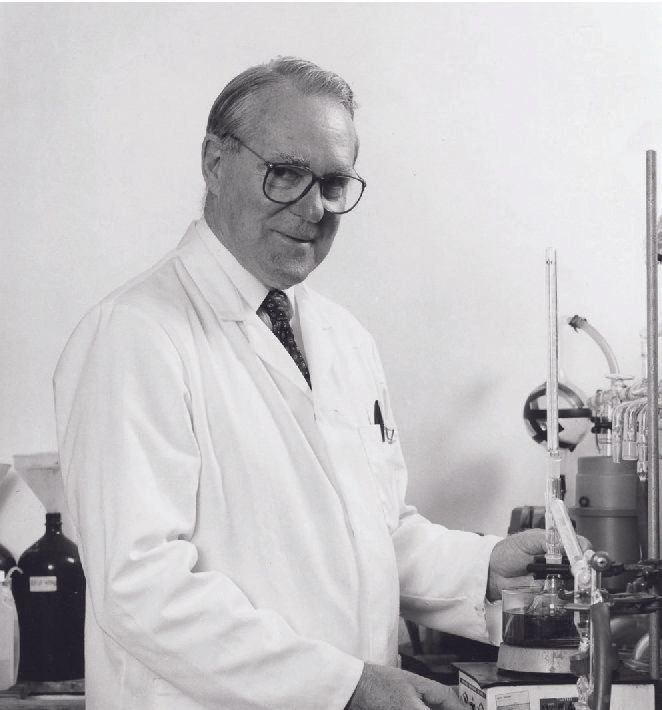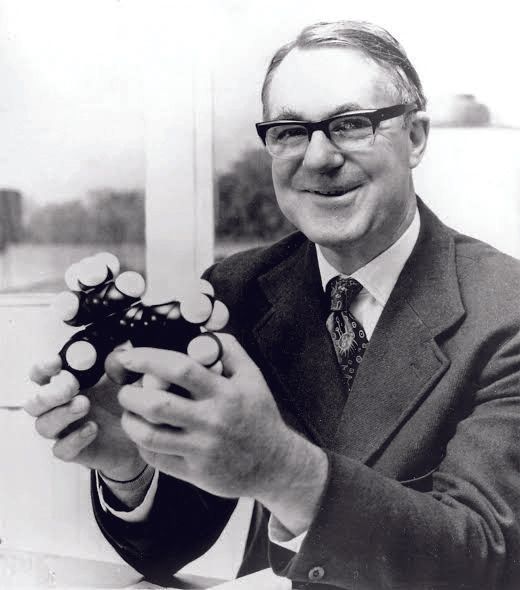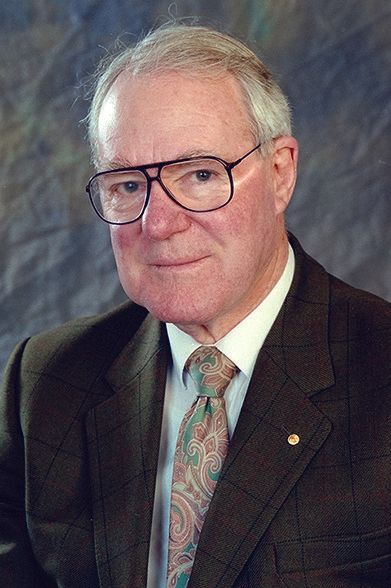Chemistry discovering the nature of lifeBy Julian Cribb
Chemistry discovering the nature of life
By Julian Cribb
John Warcup Cornforth 1917-2013
Nobel Prize in Chemistry 1975
Shared with Vladimir Prelog
A crippling ear disease that left him deprived of hearing did not stop John Cornforth in his quest to uncover the wonders of science.
A crippling ear disease that left him deprived of hearing did not stop John Cornforth in his quest to uncover the wonders of science.
Known to his friends as "Kappa", John Warcup Cornforth was born September 7 1917, in Sydney. His father was a British-born school teacher of English and classics and an Oxford graduate; his mother was a hospital nurse and descended from a German minister who had settled in New South Wales (NSW) in 1832. John was the second of four children. He started suffering the first signs of deafness, cause by the progressive disease otosclerosis, at age 10. By the time he was 20 the bone growth near his middle ear meant Cornforth was unable to hear and had permanent tinnitus, or a ringing in his ears.
However, he developed a profound insight into aspects of both nature and human nature that would eventually lead him to the pinnacle of scientific attainment: the Nobel Prize. Cornforth's childhood was spent in Sydney and in the rural surrounds of Armidale, in the New England region of NSW, where his later fascination for understanding the natural world was gradually awakening. "Looking back at the time some 70 years ago when the love of science took hold of me, I think of no big event but of many small things that influenced me," he once recalled. He says as a child he read books and learned lessons but did not have much curiosity about the natural world. This began to change when he looked at the stars- in fact, he became known for his ability to tell time by the stars - and he says he entered science through astronomy.
At Sydney Boys High School, a young chemistry teacher, Leonard Basser, captured and inspired Cornforth's eager mind, encouraging him both to think and to experiment. His deafness was encroaching and chemistry appeared to be a profession he could pursue in spite of it.
A LAUNDRY LABORATORY
At 14, Cornforth constructed a small chemistry laboratory at home in his mother's laundry and was conducting his own experiments with a sense of growing absorption and fascination that never deserted him. "At the time one could buy small amounts of many common chemicals and I made a little laboratory at home, with improvised equipment to study chemical reactions," he said. "I soon discovered that the organic chemicals were the most interesting. With the help of a textbook on practical organic chemistry I made many preparations using cheap chemicals to prepare those that were too expensive to buy. "This was more satisfying than astronomy: you could change things by your own effort. At that time I was rapidly losing my hearing so I suppose the work attracted me also for its impact on the other senses: the beauty of crystals and distilled liquids, the colours of dyes and smells - both good and bad." Cornforth saw himself as a craftsman of the fundamental components of nature. "As a carpenter or carver learns to work with the grain of wood or bone, I learned that each substance has its own nature and can be easy or difficult to handle according to the procedure chosen," he said. "I began to see experiments as I see them now, not only as procedures to answer questions or to make compounds but as opportunities to observe what happens and to learn from mistakes." John Cornforth was well ahead of his years at school and entered Sydney University at the age of 16.
By this time he was unable to hear any lectures and became an accomplished lip reader. He was also blessed with an extraordinary visual memory and learned a great deal from handbooks and journals. Many of them were in German, which he did not know, but he found a German dictionary and looked up each word until he understood them all. Cornforth says that reading the original scientific literature helped him to become a scientist because it showed the evidence behind the things that he was being taught - and some of this evidence was wrong. "The most liberating thing was the realisation that the literature wasn't entirely correct," he said. "It gave me quite a shock at first and then a thrill, because I can set this right. Always, and ever since, I've relied upon the primary literature exclusively. I don't believe a word I ever read in any textbook. I began to see science as a continuous process of discovery and correction and myself as a part of this process." During his life at university there came a second moment of revelation, this time on a bush walk in the Blue Mountains to the west of Sydney with friends. "One morning we were resting beside a river," he said. "I turned over so that my face was close to the grass and I began to count all the different kinds of plants that I could see. There were more than 20, all different, each beautiful in its own way. For me this was a kind of conversion because I had never looked at things in that way before. This was really the beginning of my curiosity about living things." Cornforth says he brought back from this walk some fruits including wild grapes and some berries with a bitter taste. He took them into the laboratory and extracted pure compounds from them. "This was not a very good way to study the chemistry of life but I began to be interested in the life sciences and to read biological text books," he said. "At that time they mostly described and classified things that nobody understood. But later, when I started to work with life scientists, I could understand their viewpoints and could use my chemistry to solve problems that interested us all. After that experience I started to look at what constituents of plants I could extract."
“I began to see science as a continuous process of discovery and correction and myself as a part of this process.” –
Cornforth
Cornforth continued to be enthralled by the breadth and complexity of chemistry. "What you can do is to form in your mind a pattern of what is possible and what is not possible in chemistry," he said. "This helps you to make new compounds and to understand new reactions and structures. When the literature or one of your own experiments presents you with a new fact, you compare it with the pattern in your mind. Often the new fact fits into the pattern easily and reinforces it but sometimes the fact does not fit." Cornforth says that when this happens, you check and sometimes you find that a mistake had been made. But if there is no mistake you must change your pattern to fit the new fact and you learn more about science on these occasions than at any other time.
BURNING QUESTIONS
Science for Cornforth begins with curiosity. "You ask questions, you read what other people have written and then you begin to find ways of answering your own questions," he said. "You never stop learning." For Cornforth, knowing the fundamentals of how something was made or worked never detracted from, but rather magnified its wonder. "Keats once said that Newton's explanation of the rainbow killed the beauty of it for him. But for me, what I know about nature simply enhances the beauty of it. I am sorry for the people who look at a flower and don't understand anything at all about what is going on." It is not unusual for Cornforth to quote poets or poetry. He says: "I use poetry as a substitute for music. I have no particular vocabulary of music in my head, but I have thousands of lines of poetry that I can recall as I like. The curious thing is that some pieces I have known for 65 years or more. And when I recall them, I find that I have sometimes improved them!" The young Cornforth was also well known for his ability to produce limericks on demand. In 1937, Cornforth graduated with first-class honours and the Sydney University medal. Along the way, he had also acquired his nickname "Kappa", which came from a habit of scratching the Greek letter into his laboratory glassware to stop fellow students from "borrowing" it, as he said.
After a year of postgraduate research he was awarded an 1851 Exhibition Scholarship to work at Oxford with Robert Robinson (who was later to nominate his colleague for the Nobel Prize). Only two of these prized scholarships were given in Australia each year. The other went to fellow student Rita Harradence, also of Sydney and also an organic chemist. In Sydney, both Cornforth and Harradence had been working in a laboratory designed by Robinson, who had become Sydney University's first professor of pure and applied organic chemistry after he arrived there from England in 1912.
Cornforth and Harradence met for the first time after she had a small accident with a valuable piece of laboratory equipment - a Claisen flask - which was difficult to come by in those days.
As a keen improviser of equipment, Cornforth had adapted an old Bunsen burner tube and taught himself to blow glass. By this stage he had earned a reputation as a glass blower and equipped himself with a proper blowpipe for the job. One of Rita's friends suggested she get him to perform the repair, which he duly did. It was the beginning of a lifetime partnership in which Harradance became his co-researcher in the chemistry lab, his ears and often his interpreter in communicating with others. Both also belonged to the Sydney University Bushwalkers Club, and walking remains one of Cornforth's abiding passions. In a reminiscence for the club's archives, Cornforth recalls: "The longest day's march I ever did was when (another keen member) Dick Welch and I arrived early one Sunday morning at Jenolan and found that we couldn't get transport that day. We wanted to be in Sydney by Monday and we knew that a train to Sydney left Mt Victoria around midnight and we decided to catch it; the walk was around 70 kilometres if I remember right. We made it, and fell asleep in our seats on the way back while out leg muscles stiffened. It was agony to get going again ... I remember saying to Dick around the middle of the walk: 'Tomorrow, we'll be laughing like hell at ourselves' and this was true. And I've never lost the taste for walking acquired in those days, and still walk around eight kilometres a day." In 1941, Cornforth and Harradence married. They have three children and several grandchildren.
It was through Cornforth's grandchildren that he discovered he had an unusual talent, given his profound deafness. "Sometimes my grandchildren have asked me to sing, and although I've explained to them that I can't sing they made me try," he said. "Apparently I can produce a melody quite accurately from something that I heard when I could hear. How that happens I don't know." Everything for Cornforth always came back to Rita. The husband-and-wife team ended up collaborating on 41 scientific papers. "Throughout my scientific career, my wife has been my most constant collaborator," Cornforth said. "Her experimental skill made major contributions to the work. She has eased for me beyond measure the difficulties of communication that accompany deafness; her encouragement and fortitude have been my strongest supports." War broke out as Cornforth and Rita journeyed to Oxford, his father's alma mater, and after completing their work on steroid synthesis for doctorates, they became part of the chemical effort on penicillin, which was the major chemical project in Robinson's laboratory during the war. "We made contributions and I helped to write The Chemistry of Penicillin (Princeton University Press, 1949), the record of a great international effort," Cornforth said. Among his most satisfying personal contributions to the chemistry of penicillin, Cornforth recalls the penicillamine story. At the time the research team was getting a pure penicillin preparation to be able to break up the molecule in various ways and penicillamine was an important fragment. Penicillamine is a chelating agent, that is, it attaches to other chemicals in the body and aids in their removal. Penicillamine is now used to remove excess copper associated with the genetic disorder, Wilson's disease. It is also used to treat severe rheumatoid arthritis. "Analysis indicated the penicillin preparation only had five carbon atoms and Robinson immediately wrote a comprehensive table of the structures that it could be," Cornforth said. "But he was misled by one piece of analytical evidence, which was what used to be called the C-methyl determination. Using the Kuhn-Roth oxidation method you boil the substance you are analysing with chromic and sulphuric (sic) acid and then you distil over any acetic acid that has been formed from that oxidation. "The amount of acetic acid was supposed to represent the number of methyl groups attached to a carbon atom. Because penicillamine gave hardly any acetic acid in that assay, they didn't like any formulae that had a methyl group. But that made it very difficult to think of a formula at all. "Robinson saw what he thought was the least improbable formula and he asked Rita and me to synthesise it," Cornforth said. "I had to visit Manchester at about this time and on the way up, it occurred to me that penicillamine might have too many methyl groups, not too few." Subsequent experiments proved he was right. After the war ended Cornforth returned to his earlier work on the synthesis of the organic molecules, sterols. His close collaboration with Robinson continued after he and Rita joined the scientific staff of the Medical Research Council and worked at its National Institute, first at Hampstead in north London and then at Mill Hill on the outskirts. By 1951, Cornforth and Robinson were able to complete, simultaneously with Woodward at Harvard, the first total synthesis of the non-aromatic steroids. Steroids are a class of naturally occurring organic substances and their derivatives that are of great importance in biology, medicine and chemistry. However, Cornforth and Robinson were always more than mere collaborators in the laboratory; they shared a close friendship that lasted until Robinson's death in 1975. "The nature of our friendship was a continuous sequence of differences of opinion," Cornforth said in 1985. "He was an argumentative person and I have known the same thing to be said of myself." At the National Institute for Medical Research, Cornforth came into contact with biological scientists and formed collaborative projects with several of them. In particular, he shared an interest in cholesterol with George Popjak. They began to collaborate in studies of its synthesis in living organisms. This was the beginning of what Cornforth recalls as the richest and most fulfilling period of his career. "I spent 16 of the best years of my life in an extraordinary place, the National Institute for Medical Research, and I know to what extent scientific advances are the product of an ambience created by many people, not just the few who tend to have the best ideas. "At this time Konrad Bloch was beginning his work on the biosynthesis of the sterols and Popjak and I began to conduct experiments in which the disciplines of chemistry and biochemistry could be applied." In 1962, Cornforth and Popjak left the Medical Research Council and became co-directors of the Milstead Laboratory of Chemical Enzymology set up by Shell Research. Lord Rothschild helped establish the laboratory and Cornforth worked under him until Rothschild left Shell in 1970. At Milstead, a project was developed that looked at the study of the stereochemistry of enzymic reactions. Stereochemistry is the study of how the properties of a chemical compound are affected by the spatial arrangement of atoms in molecules and complexes. Not only can a compound have more than one geometric form, but chemical reactions can also have specificity in their stereochemistry, thereby forming a product with a particular three-dimensional arrangement of the atoms. This is especially true of reactions in living organisms. Cornforth mainly studied enzyme-catalysed reactions. Stereochemically-specific reactions have great practical importance, as many drugs, for example, are active only in one particular geometric form. Cornforth's stereochemistry work continued after 1968 when Popjak left Milstead to go to the University of California in Los Angeles. In 1975, the same year that Rita chose to retire, Cornforth left Shell to take up a position as Royal Society research professor at the University of Sussex.
Cornforth's work at Milstead led directly to the 1975 Nobel Prize in Chemistry for clarifying the stereochemical control of enzymic relations. Some substrates for enzymes contain carbon atoms that become chiral - left- or right-handed in structure when one of the attached hydrogen atoms is replaced by deuterium (an isotope of hydrogen that has twice the mass of ordinary hydrogen). This labels the compound, and examination of the label in the product can throw important light on the reaction mechanism. One problem was how to measure the tiny optical activity generated by replacing one hydrogen with deuterium in otherwise symmetrical molecules. (Later it became possible to make methyl groups chiral by using all three hydrogen isotopes and to measure the chirality without using optical rotation.)
OPTICAL ASSISTANCE
"It was necessary to measure the optical activity and looking at all the methods that were available, I could see that it was going to be nearly impossible," Cornforth said. "I wrote to a friend in Australia who was an expert in optics and I asked him whether there was anything in the pipeline for measuring very small optical activity. "He told me to go to the National Physical Laboratory as they were evolving a prototype. It was a marvellous instrument but it was a lash-up of all kinds of components. We did our bio-chemistry and chemistry and got two specimens of mono-deuterio succinic acid in which the molecules are mirror images of each others. We had a few milligrams of each of these and we also had a third specimen which we had much more of, which was made from a product in which we were sure of the stereochemistry. "We took these three specimens to the National Physical Laboratory at Teddington (on London's edge) and they did the optical rotations. They came out bea utifully. The two dispersion curves of the two compounds were mirror images of each other, one going up Like this, the other going down like that, a perfect dispersion. I think that's the day I remember with the most pleasure in my experimental life." There came another memorable day when, shortly after Cornforth had moved from Shell to the University of Sussex in 1975, his wife Rita telephoned to tell him she had just heard it announced on the BBC news that he had been awarded a Nobel Prize for his work.
"I was quite surprised," he said. "I had estimated my chances at about one in three. As for the ceremony, I couldn't hear a word of what was said. I amused myself by looking around at the audience. It was in this sports stadium, an enormous place, because the town hall was being refurbished but I could see in the darkness of the auditorium these flashes of bright light. They kept on like this and I couldn't make out what they were. And finally I realised all the women were wearing jewels, and that was what was causing the flashes of light. That was the thing I remember most of all from the ceremony." As well as a gold medal and prize money, obel Prize recipients receive a personal diploma depicting their achievement. Cornforth's diploma had a drawing of two molecules, which were supposed to be the mirror-image forms of acetic acid. Associate professor Damon Ridley, who spent study leave in 1978-79 with Cornforth, said: "But the cartoonist drew two identical structures, so the certificate has a scientific flaw. This appeals to Kappa's sense of humour." In 1977, Cornforth's Nobel Prize was followed by a British knighthood, which came after wide professional recognition of his skills as a scientist. Memorable for others was Cornforth's brief yet powerful speech of acknowledgement on behalf of himself, Vladimir Prelog, and their colleagues: "That our work has been considered worthy of such distinction is a great satisfaction to us both but I think that we derive equal satisfaction from the sense of being nvo in the great company of those who approach the truth. "In a world where it is so easy to neglect, deny, corrupt and suppress the truth, the scientist may find his discipline severe. For him, truth is so seldom the sudden light that shows new order or beauty; more often, truth is the uncharted rock that sinks his ship in the dark. He respects all the more those who can accept that condition; and in returning thanks tonight we are saluting all those who made out load lighter by sharing it."
Vital Statistics
Name: John Warcup Cornforth
Born: Sydney, Australia
Died: Brighton, England
Birthdate: September 7 1917
Died: December 8 2013
School: Sydney Boys High School
University: Sydney University; Oxford University
Married: Rita Harriet Harradence in 1941
Children: Three
Awards and Accolades
1953: Elected to the Royal Society
1953: Chemical Society’s Corday Morgan Medal
1965: Flintoff Medal
1967: Stouffer Prize
1968: Royal Society’s Davy Medal
1972: Prix Roussel
1975: Nobel Prize in Chemistry
1975: Australian of the Year
1977: Awarded a British Knighthood
1982: Royal Society’s Copley Medal
Why he was awarded a Nobel Prize
In 1975, John Cornforth and Swiss Chmist Vladimir Prelog were awarded the Nobel Prize in Chemistry. Cornforth was awarded for his work on the stereochemistry of enzyme-catalysed reactions. This subject is quite complex and related to geometry in three dimensions. It is concerned with the delicate mechanism of important reactions in biological systems, where a group of atoms takes the place of a certain hydrogen atom among two or three, which may appear to be equivalent. The problem is to decide which of the hydrogen atoms is replaced and if the nearby groups retain their positions or if they are rearranged in some way. The enzyme leads the process in a uniform way; without this guidance, chaos would break out in the biological system.
Cornforth “marks” the hydrogen atoms by making use of hydrogen’s three isotypes; ordinary hydrogen (mass 1), heavy hydrogen (mass 2) and radioactive hydrogen or tritium (mass 3). He then makes use of their differing reaction speeds (the lightest reacts the quickest). Only trace quantities of tritium can be used; no more than a millionth or so of the molecules involved in the reaction are marked. The planning of this research is an outstanding intellectual achievement. Among the biologically significant reactions the stereochemistry of which has been clarified is the synthesis of steroids from mevalonic acid via squalene and condensations of acetate with glyoxylic acid to citric acid. Since Cornforth showed the way, similar research has been initiative in other quarters.
